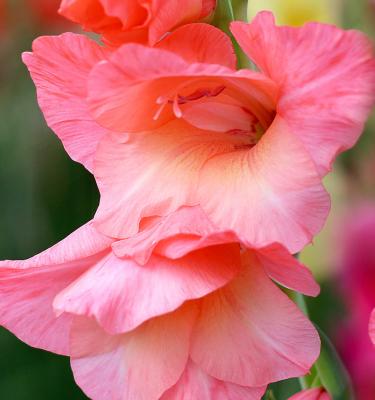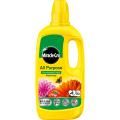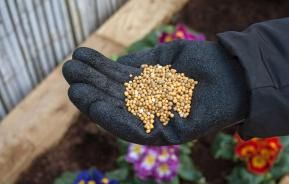Growing gladioli is a brilliant way of bringing a glorious array of colours to the summer garden. And, of course, you can cut the flower spikes for indoor flower arrangements.
How to grow gladioli
Cultivating gladioli
Gladioli need a sunny position and good, well-drained soil with plenty of organic matter.
Dig over the planting area to a depth of 20-25cm (8-10in) and improve the soil with well-rotted compost, soil conditioner or planting compost to help hold plenty of moisture to ensure good quality blooms from the gladioli.
Gladioli varieties
Gladioli are available in a range of types - from dainty miniatures, graceful primulinus hybrids all the way up to giant varieties with flowers up to 15cm (6in) in diameter, growing 1.8m (6ft) tall.
The vast majority of gladioli aren’t totally hardy, but Gladiolus byzantinus and Gladiolus communis can cope with milder winters, down to -10°C (14°F), and can be left in the garden from year to year, especially if protected with a soil mulch covering.

Planting gladioli
Plant the corms every couple of weeks from March to May for a succession of flowers right through the summer and into autumn. They don’t appreciate being planted too early in spring when the soil is too cold – when deciduous trees come into leaf is a good indicator to start planting.
In heavy soils, it pays to plant the corms on a 5cm (2in) thick layer of sharp sand or gravel to improve drainage.
Before planting, apply a general granular plant food to the soil.
The corms should be planted 12.5-15cm (5-6in) deep, either in trenches or in individual holes. In heavy soils, plant 10-12.5cm (4-5in) deep. The spacing depends on the height and type, from 10-20cm (4-8in) apart.
Where to plant gladioli
Plant gladioli in city and courtyard gardens, cottage and informal gardens, patios, containers.
How to care for gladioli
When the plants have produced 5 or 6 leaves, the taller varieties will need some support. Bamboo canes with string or similar ties are the easiest method, but don’t tie too tightly as this will strangle the developing flowerhead. Always ensure the stakes are inserted away from the base of the plant to avoid damaging the corm.
Plants will need watering during any periods of prolonged dry weather to prevent the soil drying out. A good soaking once a week – to give about 2.5cm (1in) of water – is the best way to water. In containers, they will need more regular – maybe even daily – watering.
Fortnightly feeding with a liquid plant feed will help promote strong growth. As the flower spikes develop, switch to a high potash feed
Lifting and storing gladioli over winter
As most varieties are not completely hardy, the corms are lifted and stored frost free for winter. In mild parts of the country you can risk leaving them in the ground – with a thick mulch over the soil – but it can be a risk. The corms are dug up after the first frost and left to dry for a few weeks. Then the new corms should be detached from the withered, older mother corms and stored in boxes or mesh bags.
| Flowering season(s) | Summer, Autumn |
|---|---|
| Foliage season(s) | Spring, Summer, Autumn |
| Sunlight | Full sun |
| Soil type | Chalky, Clay, Loamy, Sandy |
| Soil pH | Neutral |
| Soil moisture | Moist but well-drained |
| Ultimate height | From 15cm (6in) to 1.8m (6ft) |
| Ultimate spread | 10-15cm (4-6in) |
| Time to ultimate height | 5 months |









